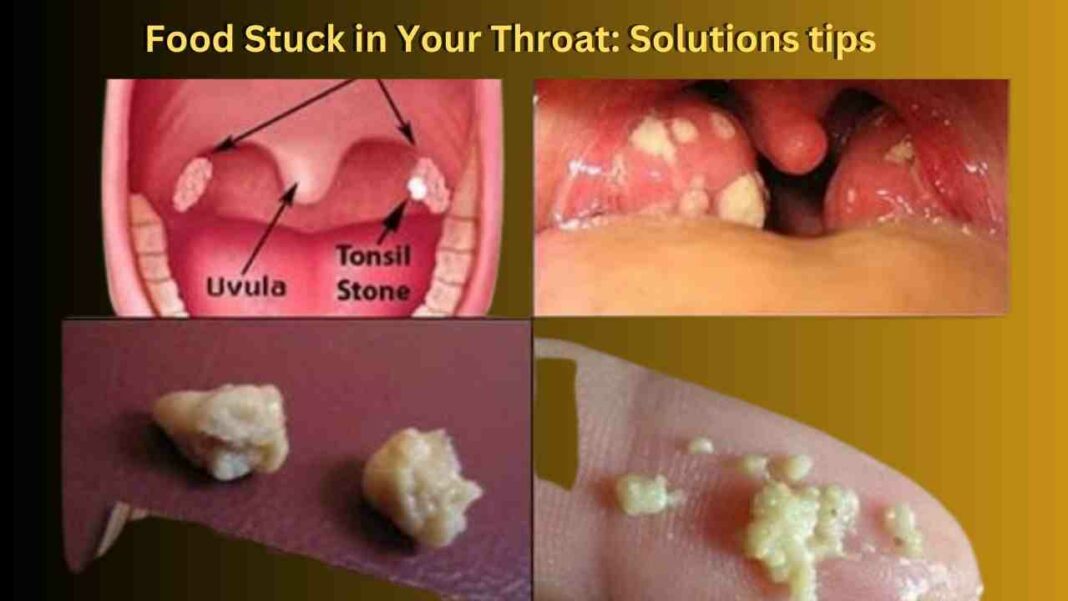Do you have the uncomfortable feeling that something is stuck in your throat? The pain of having something stuck in the stomach can be alarming, leading to feelings of unease and concern. In these situations, it’s very important to know effective home remedies and important emergency tips.
When you’re in this kind of pain, knowing how to ease the feeling and handle possible emergencies can make all the difference. From soothing remedies like warm water sips to urgent interventions for choking incidents, this article will guide you through practical steps to address the issue of food stuck in your throat.
Join us as we explore simple yet effective ways to relieve this discomfort and handle emergencies with ease.
Understanding the Swallowing Process and Potential Obstructions

Swallowing is a complicated process that uses nerves and muscles to move food from the mouth to the stomach. Starting with chewing food into a wet bolus, the tongue moves it toward the throat, where the windpipe temporarily closes to help the food move into the esophagus.
The feeling of food being stuck in the throat can happen, though, because of foreign objects. Inadequate chewing, structural problems, esophageal disorders, or neurological problems could all cause these problems. Feelings of discomfort, pain, or food getting stuck can be caused by these conditions.
Understanding how to swallow and spot these problems is very important. By helping people notice when an obstruction happens, they can quickly fix the problem or get medical help to avoid issues.
Recognizing the Sensation of Food Stuck in the Throat
When food gets stuck in your throat, it can trigger various sensations and discomfort. Understanding these signs is crucial for timely intervention and relief.
Sensations Associated with Food Stuck in the Throat:
- Feeling of Blockage or Obstruction:
- Individuals might experience a persistent sensation of something being stuck in their throat, causing discomfort while swallowing or talking.
- This sensation might vary from mild to severe, often persisting even after attempts to swallow or clear the throat.
- Discomfort or Pain in the Throat Region:
- One may feel a localized pain or discomfort in the throat area, which can range from mild irritation to sharp pain, depending on the severity of the obstruction.
- This discomfort might worsen while eating or drinking, particularly when attempting to swallow solid foods.
- Difficulty in Swallowing or Speaking:
- Individuals might find it challenging to swallow food or liquids, experiencing a sensation as if the food is not moving down the esophagus properly.
- Some may notice difficulty in speaking clearly or experience changes in their voice due to the obstruction.
- Persistent Coughing or Gagging Reflex:
- A persistent cough or an urge to cough frequently without any apparent cause can indicate an obstruction in the throat.
- The gag reflex might also be triggered repeatedly as the body attempts to dislodge the stuck food.
- Feeling of Panic or Anxiety:
- Experiencing food stuck in the throat can lead to feelings of panic, anxiety, or unease due to the discomfort and potential difficulty in breathing.
- This sensation might cause distress, especially if it’s a recurring issue or if the person has a history of choking incidents.
What happens if food stays stuck in the throat?
When food remains lodged in the throat, it can lead to various uncomfortable and potentially serious consequences:
- Discomfort and Pain: The presence of food stuck in the throat can cause significant discomfort, pain, or a sensation of pressure, making swallowing difficult and uncomfortable.
- Risk of Choking: If the blockage partially or fully obstructs the airway, it poses a choking hazard. Severe obstruction can impede breathing, leading to a life-threatening emergency.
- Esophageal Irritation or Inflammation: Prolonged presence of the stuck food can irritate the lining of the esophagus, leading to inflammation (esophagitis). This inflammation can cause pain and may further obstruct the passage of food.
- Risk of Aspiration: In some cases, the lodged food might move into the airway (aspiration), leading to coughing, difficulty breathing, or even lung infections if the food enters the lungs.
- Potential Tissue Damage: Continuous pressure from the stuck food can cause tissue damage, leading to swelling or even ulceration of the esophageal lining.
- Inability to Swallow Saliva: Depending on the severity of the obstruction, individuals may find it challenging to swallow even their saliva, causing further discomfort and distress.
If food remains stuck in the throat, especially if accompanied by symptoms such as persistent difficulty swallowing, chest pain, or breathing difficulties, seeking immediate medical attention is crucial. A healthcare professional can perform an evaluation, potentially using imaging tests or endoscopy, to remove the blockage and prevent any complications that may arise from the lodged food.
Emergency Scenarios: Differentiating Between Choking and Non-Choking Incidents
In emergency scenarios related to a sensation of food stuck in the throat, it’s crucial to differentiate between choking incidents and non-choking situations. Understanding the differences helps determine the appropriate course of action:
Choking Incidents:
- Breathing Difficulty: Choking occurs when the airway is partially or completely blocked by the stuck food or foreign object. Individuals may struggle to breathe, experience noisy or labored breathing, or exhibit signs of respiratory distress.
- Inability to Speak or Cough Effectively: Those choking might be unable to talk or cough forcefully due to the obstruction. They might display panicked behavior, clutch their throat, or make gagging motions.
- Change in Skin Color: The person might show signs of cyanosis, where their skin, particularly around the lips or fingertips, turns bluish due to inadequate oxygenation.
Non-Choking Incidents:
- Difficulty Swallowing: Individuals experiencing food stuck in the throat without completely obstructing the airway might still swallow saliva or liquids, albeit with discomfort.
- Persistent Discomfort: They may express a sensation of something being lodged in their throat, experience localized pain, or feel discomfort while swallowing or talking.
- Ability to Breathe and Speak: Despite discomfort, those in a non-choking incident can usually speak and breathe, though they might cough or gag occasionally.
Immediate Actions:
- Choking: For someone visibly choking, it’s essential to perform the Heimlich maneuver by applying abdominal thrusts to dislodge the blockage. If the person becomes unconscious, call emergency services and start CPR.
- Non-choking: In cases where the airway is not completely obstructed, encourage the person to drink small sips of water to help dislodge the food. If discomfort persists or escalates, seeking medical attention is recommended.
Understanding these distinctions is critical in determining the urgency of the situation and the appropriate steps to take. If unsure about the severity or if the situation deteriorates rapidly, seeking immediate medical help is crucial to prevent complications.
Effective Home Remedies: Ways to remove food stuck in the throat
When experiencing the discomfort of food stuck in the throat, several home remedies can help alleviate the issue before seeking medical attention. These methods aim to dislodge the obstruction and ease the sensation of blockage:
Effective Home Remedies:
- Drink Warm Water: Sipping warm water can help moisten the throat and potentially soften the stuck food, making it easier to swallow or dislodge.
- Try Saline Gargles: A saline solution gargle made by mixing salt in warm water might help in loosening the food particles and providing relief.
- Coughing Technique: Controlled coughing might aid in dislodging the food. Lean forward slightly and cough to potentially push the obstruction upward.
- Consume Carbonated Beverages: Carbonated drinks like soda or seltzer water can create gas bubbles, exerting pressure that may help dislodge the food.
- Effervescent Remedies: Effervescent tablets or solutions like Alka-Seltzer when mixed with water can create fizz, which might aid in breaking down the obstruction.
- Eat Soft Foods: Consuming moist and soft foods like bread soaked in water or milk, mashed potatoes, or applesauce might help push down the stuck food.
- Use Gravity: Tilt your head forward while swallowing to utilize gravity, potentially aiding in dislodging the food.
- Avoid Forceful Swallowing: Refrain from forceful attempts to swallow, as it might further lodge the food or cause throat irritation.
Medical Interventions: When to Seek Professional Help for Persistent Issues
In situations where food remains stuck in the throat or if there are persistent issues despite attempting home remedies, seeking prompt medical intervention is crucial. Certain scenarios warrant professional medical attention to address the underlying cause and alleviate discomfort:
When to Seek Professional Help:
- Persistent Discomfort: If the sensation of something stuck in the throat persists or worsens over time, it’s advisable to consult a healthcare professional for evaluation.
- Difficulty Swallowing Liquids or Solids: Inability to swallow even liquids or soft foods due to persistent blockage or discomfort requires medical assessment.
- Breathing Difficulties: Any difficulty in breathing, whether mild or severe, associated with the feeling of obstruction in the throat necessitates immediate medical attention.
- Persistent Pain or Chest Discomfort: Severe pain, chest discomfort, or persistent coughing associated with the lodged food requires urgent evaluation.
- Inability to Speak or Persistent Gagging: If the person cannot speak, has ongoing gagging, or exhibits signs of distress due to the obstruction, seek immediate medical help.
- Recurrent Episodes: Individuals experiencing frequent instances of food getting stuck in the throat should consult a healthcare provider to explore underlying causes.
- Previous Esophageal Issues: Those with a history of esophageal problems or conditions such as GERD, esophagitis, or narrowing of the esophagus should seek medical advice promptly.
Medical Evaluation and Intervention:
- A healthcare professional will conduct a thorough assessment, potentially using imaging tests like X-rays or endoscopy to visualize and remove the lodged food.
- Treatments might involve the use of specialized instruments to dislodge the obstruction or, in severe cases, endoscopic procedures to safely extract the stuck food.
Innovative Solutions: Exploring Unconventional Techniques for Easing Discomfort
When conventional methods fail to relieve the discomfort of food stuck in the throat, exploring unconventional or innovative solutions might offer additional relief. While these methods might not be universally recognized, some individuals find them helpful in easing the sensation of blockage:
Innovative Solutions:
- Apple Cider Vinegar (ACV) Solution: Diluting a tablespoon of apple cider vinegar in water and sipping it slowly might help dissolve or dislodge the stuck food. The acidity of ACV could assist in breaking down the obstruction.
- Chewing Gum: Chewing sugarless gum might stimulate saliva production, which, in turn, could help lubricate the throat and potentially aid in dislodging the food.
- Throat Massage: Gently massaging the neck and throat area externally might alleviate discomfort and encourage movement that could assist in dislodging the obstruction.
- Warm Compress: Applying a warm compress or using warm water packs on the throat externally might help relax muscles and ease the sensation of blockage.
- Herbal Teas or Decoctions: Some individuals find relief by consuming warm herbal teas like chamomile or slippery elm that are known for their soothing properties.
- Specific Body Movements: Certain yoga poses or controlled body movements might promote relaxation and encourage movement that can potentially aid in dislodging the stuck food.
While exploring innovative solutions could offer relief in some cases, it’s crucial to exercise caution and discretion. Persistent discomfort or worsening symptoms should prompt seeking professional medical advice to prevent complications and ensure appropriate management of the issue related to the stuck food in the throat.
Conclusion.
Experiencing the discomfort of food stuck in the throat can be distressing, but various strategies can help alleviate this sensation. Recognizing the signs, understanding the swallowing process, and knowing when to seek professional help are key components in managing this issue effectively.
From recognizing the sensation of food lodged in the throat to differentiating between choking and non-choking incidents, individuals can take proactive steps. Home remedies such as drinking warm water, trying saline gargles, or consuming carbonated beverages may provide initial relief.
However, if persistent issues arise or breathing difficulties, persistent pain, or recurring episodes occur, seeking immediate medical attention becomes imperative. Professional medical interventions, including imaging tests or endoscopic procedures, help diagnose the underlying cause and safely remove the obstruction.
Exploring unconventional techniques like apple cider vinegar solutions or throat massages might offer additional relief for some individuals. Yet, it’s crucial to exercise caution and consult healthcare professionals, especially for those with existing medical conditions.
Thank you for joining us on this fitness journey! We hope you found our blog insightful and inspiring. Our aim is to provide you with valuable information, expert advice, and motivational content to support you in your wellness endeavors.
Related Post
- Immunity 101: The Best Juices to Boost Your Immunity This Winter
- Unlocking the Mystery of Temporomandibular Joint (TMJ)
- Understanding Stomach Acid Burns on Skin
- Understanding Sinus Infections: Are Contagious or Not?
-
Robitussin DM: Your Complete Guide to Ingredients, Dosage, and Side Effects

Meet Pradeep Singh, your go-to guide for all things fitness, health, and motivation. With over 7 years in the field, Pradeep brings a blend of expertise and real-world experience to his writing. From workout tips to healthy living insights, he simplifies complex topics, making fitness accessible for everyone. His authentic approach and genuine passion aim to inspire and support your wellness journey. Get ready to embark on a path to a healthier lifestyle with Pradeep as your trusted companion and motivator.






















